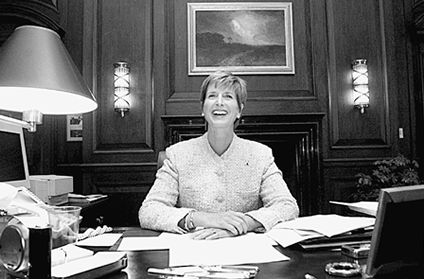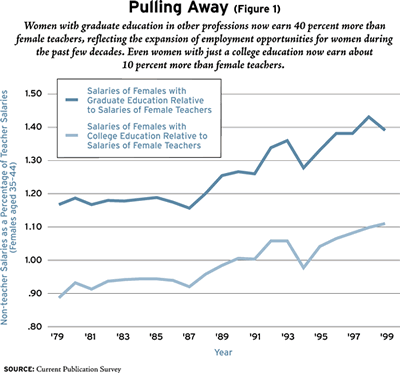 |
| For decades the nation has been able to school its children on the cheap by exploiting a trapped workforce of educated women. Those days are long gone. Illustration by Gordon Studer.
|
Are teachers underpaid? As an economist, I find it difficult to question market outcomes. Goods and services generally cost the market price. Only in the event of some kind of “market failure” do we say that goods or services are either over- or underpriced—meaning that they cost more or less than the price would have been in a fluid, competitive market.
At first glance, it is hard to see how the market for teachers could fail. True, most teachers’ salaries are set by governments in a noncompetitive environment. But candidates choose freely whether to become teachers, in full knowledge of what salaries they will receive. In this sense, the people who choose to become teachers are paid a salary commensurate with their skills, preferences, and working conditions. These teachers are not underpaid relative to what they could earn in other occupations.
But what if we wanted to draw a higher-quality pool of candidates to teaching? Are we paying too low a price to accomplish that? I argue that the market for teaching has failed—in the sense that we are paying low salaries for low-quality teachers when we would prefer high-quality teachers. This is the result of two main flaws in the market: the difficulty of identifying who will be a good teacher and the reliance on an obsolete conception of the pool of potential teachers.
 |
| The rise of a generation of powerful female politicians, including U.S. Environmental Protection Agency administrator Christine Todd Whitman, pictured here, is deeply symbolic of the dramatic change in women’s opportunities during the past century. Photograph from AP World Wide.
|
Squeezing the Lemons
Nobel Laureate George Akerlof’s “lemons model” of market failure helps to explain why schools may not be willing to pay the market price for good teachers. Consider the market for used cars. Buyers want to purchase good cars, but they wonder if only “lemons” are put up for sale. And they have no easy way of evaluating whether a particular car is a lemon. They can look under the hood, take it for a test drive, even ask for the owner’s service records, but none of those will guarantee a vehicle’s integrity. The buyer’s concern for quality without a corresponding ability to evaluate that quality can cause markets to fail. Buyers may not be willing to pay the price necessary to draw high-quality cars into the market, thus ensuring that the proportion of lemons in the market will be higher than if the market were functioning well.
Likewise, schools are deeply concerned with the quality of their teachers, but quality is difficult to discern when hiring a new teacher. Studies have found that graduating from a good college and achieving high scores on tests of verbal aptitude are reasonable, though highly imperfect, indicators of teacher quality. In addition, licensing and certification rules attempt to ensure that teachers possess a certain level of skills. Nevertheless, many of the attributes that make for a good teacher are outside the bounds of a regime for testing or licensing teachers. A high-quality teacher is one who can energize and motivate students in addition to imparting information—qualities that are hard to recognize at the hiring stage. Teachers themselves may know how good they are, but the principals and school boards who hire them have far less information, as in the lemons model. They might desire a higher level of quality, but they are reluctant to pay the salaries necessary to obtain it because of the difficulty of choosing quality teachers.
Teachers are thus underpaid in the sense that we are paying low salaries for low-quality teachers. If we wanted, we could reach a different point in the market, where we would pay high salaries for high-quality teachers. As with used cars, a small salary increase would not change the quality of aspiring teachers; only a dramatic increase would attract a different pool of candidates and prove sustainable. It has been hard to make this kind of radical change because of historical patterns in the workforce that once allowed schools to educate on the cheap.
Women’s Work
Women once considered teaching a highly attractive profession because their opportunities were tightly circumscribed. Despite the low wages, teaching was a far better line of work than slaving away in a textile mill. However, the past half-century opened a vast new world of opportunities to educated women. The nation’s failure to accommodate these recent changes has kept teachers’ salaries artificially low.
In Massachusetts the proportion of teachers who were women rose from half to more than 85 percent during the 19th century. By the 1920s almost all elementary-school teachers in the United States were women. They never were a large proportion of employed people in New England or even of employed women, but on average teachers taught longer than women worked in other occupations. The pool of female teachers comprised two quite different groups. Those who got married after starting out as teachers taught for about four years on average. But a large proportion of teachers did not marry. Thirty percent of teachers remained single, compared with 15 percent of New England women, after the Civil War. These single teachers taught an average of 12 years, raising the average tenure of teachers.
At the time, teaching was an unusually attractive career for women, compared with the alternatives. Almost two-thirds of Massachusetts women who earned wages in 1837 worked in their homes, producing goods such as palm-leaf hats, straw bonnets, and shoes and boots. The next most important employers of Massachusetts women in the 1830s were the cotton mills. As the century progressed, domestic service replaced braiding hats, but roughly half of employed women continued to work in textiles and the needle trades. This pattern began to erode during the early 20th century. As store-bought goods and services increasingly replaced those made in homes, women were increasingly demanded for work outside the home. Firms began to hire women to perform the market equivalent of homemaking: cleaning, cooking, and caring for the sick. The increasing need for clerical workers and the invention of the typewriter also afforded better jobs for women.
The participation of women in the labor force grew rapidly during the 20th century, from less than 20 percent of women in 1890 to well over 50 percent today. But women continued to have a narrow range of job choices for the first two-thirds of the 20th century. While the choices were not as restricted as in the 19th century, it should not be surprising that as late as 1960 many jobs held by women were still in cotton goods, clothing, and boots and shoes.
Only in the current generation have opportunities for women opened up. Previously, school boards hired female teachers in a context of little competition. Even in the mid-20th century, with opportunities still limited, teaching remained a good job, one that was considerably more interesting and probably more attractive than the alternatives. Schools didn’t need to pay high wages in order to attract high-caliber individuals. High-quality women went into teaching anyway.
Then the market for teachers changed. The opportunities for women have expanded considerably, and their ability to get professional education has increased. In this new world, the brightest women go toward the best jobs. These jobs increasingly are not in teaching. In this kind of market, a higher salary is necessary to compete for higher-quality candidates, who now have other interesting career choices.
Harvard professor of education Richard Murnane argued a decade ago that there were many reasons why good candidates did not go into teaching, and salary was high on the list. In 1988, when the average starting salary for teachers was $19,600, business and industry offered average starting salaries of $28,900 for physics majors, $25,900 for chemistry majors, and $21,000 for humanities majors. The large salary gap for science majors surely discouraged them from entering teaching. Dedicated individuals and poor students who did not anticipate doing well in business still went into teaching, but low salaries discouraged many bright and vigorous students.
Using data on teachers’ test scores from North Carolina, Murnane found that teachers with high test scores left teaching sooner than those who did less well. This is not surprising; we may presume that high-scoring teachers had access to better jobs than low scorers. Murnane also found that teachers who were paid more stayed in teaching longer. Taken together, these results showed that low salaries not only discouraged good students from becoming teachers, but they also discouraged good students from remaining teachers. The results of recruitment and retention are consistent; low salaries were associated with low-quality teachers.
New York University economist Frederick Flyer and the late University of Chicago economist Sherwin Rosen standardized teacher salaries for the demographic composition of teachers. They found that what they called the true real wage of teachers has declined relative to wages for other college graduates and has declined even more relative to female college graduates, especially for teachers in elementary schools. Most of this decline took place during the 1970s, when school enrollments fell, but relative wages have not recovered as enrollments have risen more recently.
To see what happened in the 1990s, I examined the relationship between average teacher salaries and women aged 35 to 44 with some graduate education. I compared teachers with women who had some graduate education to capture the comparison between teachers and women who have gone on to get degrees in subjects other than education (see the top line in Figure 1). Highly educated women who were not teachers earned more than teachers throughout the past 20 years. The wage premium stayed under 20 percent until around 1987, and it has risen steadily and strongly since then. The wage premium for women who have some graduate education and are not teachers is now 40 percent. This trend shows that teachers’ salaries are falling behind those of highly educated women in other fields at a rapid rate.
Now, many high-school teachers have master’s degrees, but most elementary teachers do not. Therefore, this comparison may not be accurate for teachers of lower grades; I may have compared them with women who have more education than they do. I cannot distinguish teachers by grade, but I can compare teachers’ salaries with women who have only college degrees. This comparison is also shown in the bottom line in Figure 1. The trends are very much the same, although the divergence of wages is less strong in the bottom trend line than in the top line. Women with just a college degree earn an average of only about 10 percent more than teachers. Relative wages for elementary teachers fell in the 1970s and declined again in the 1990s.

Quality Control
The earnings comparisons tell only part of the story. The career choices open to women have expanded greatly in the past generation. This, coupled with the appearance of women with extensive experience in the workforce, has resulted in rising earnings for professional women. In addition, it has opened up jobs that are more interesting and challenging, careers that are more fulfilling. If there were a way to adjust for the expanding choices for educated women, the gap between teachers’ earnings and alternative “earnings” would be larger than those shown here.
There also may be a sample-selection problem in the college-only comparison. If the brightest of women seek education after college, then the control group in the bottom trend line of Figure 1—women with only four years of postsecondary education—is self-selected to be of lower quality. The comparison in the figure reveals that teachers earn less than even those women who choose not to pursue their education beyond an undergraduate degree.
Finding themselves with lower-quality teachers, school districts have imposed work standards on teachers to make sure they are doing their jobs. These restrictions on teachers’ creativity have made teaching an even less desirable job than is indicated by the salary. This is revealed most vividly in the relations between teachers and administrators. The latter feel obliged to keep tight control over teachers, and they set tasks for them to maintain minimum standards. Lesson plans and other reports increase the workload of teachers and force them into a uniform pattern. Of course, these work rules also discourage the most adventurous and creative teachers.
In some urban schools, principals feel free to discipline teachers in front of their students. This process humiliates the teachers and undermines their authority. Teachers are publicly criticized for not keeping their lines straight, for not being in “homeroom circle” properly, and for other minor infractions of classroom neatness. A Boston middle-school teacher told me that her principal yelled at her for forsaking her lunch duty place briefly to get food for a student whose lunch she had had to confiscate earlier. This is the kind of discipline that is designed to discourage all but the most dedicated of creative teachers.
Standardized tests, the cornerstone of the federal No Child Left Behind Act, are another way of monitoring teacher performance. The new purpose of the tests is to evaluate the schools and the teachers within it. Tests previously were used to evaluate students, but annual testing was unnecessary for this purpose. The new policies are meant to keep a tight rein on teachers rather than students.
Tests, like excessive paperwork and humiliating disciplinary actions, make life miserable for teachers. They force teachers to teach to the tests, reducing the scope of their teaching. They direct attention to skills that can be measured on annual objective tests and away from learning that is more subtle or long-term. For example, we charge the public schools with promoting civic responsibility. It is not clear how one would test this by multiple choice or if one would look for steady year-to-year increases in this set of attitudes. Less tangible and more creative parts of teaching are discounted relative to the basic mechanics of teaching. If low salaries do not drive creative teachers away, excessive discipline and annual tests should do so.
I do not mean to throw the baby out with the bathwater. Any dramatic increase in salaries will have to be accompanied by an increase in accountability. Inevitably, teachers’ performance will have to be measured by some sort of tests. But the current crop of tests appears to be aimed only at evaluating minimum competence. Such tests tend to stultify the most creative teachers even as they, at least in theory, help the worst students.
Principals also may be more a part of the problem than the solution. They are recruited from the pool of teachers, and their quality has also suffered a decline. In the past, the demands on principals—to preserve order and maintain the school building—were consistent with their abilities. But if we wish to move to a point where good teachers will be rewarded for excellence and all teachers will be held accountable for their performance, it is far from clear that the current stock of principals will be adequate. To make tests an effective device for monitoring and rewarding quality, school administration as well as the tests themselves will have to be improved almost beyond recognition.
 |
| Fifty years ago, the only attractive option for a supremely talented woman like Carly Fiorina might have been to become a teacher. Today she is the CEO of Hewlett-Packard. Photograph from AP World Wide.
|
Higher Aspirations
For most of U.S. history, the nation has been able to operate schools at low cost by exploiting the trapped labor force of educated women who had few other opportunities. Now schools must compete with other mentally and financially rewarding occupations as they recruit teachers. Surely it is immoral for us to shortchange our schools because we cannot bring ourselves to pay enough to attract good teachers.
The underpayment of teachers is likely to have important implications for the future of the American economy. The economy’s success during the 20th century was due to many factors, of which the broad sweep of American education was an important one. The United States led the world in spreading education to the masses. The American economy grew consistently during the 20th century because we constantly upgraded the quantity and quality of our human capital. The United States has been successful both politically and economically because people have been able to transcend their origins and reach heights undreamed of in earlier times and other places. Education has been one of the primary paths through which extraordinary individuals have found an outlet for their gifts. We should try our best to preserve this commendable quality of American life.
Further education reforms will be hampered by low teacher quality as long as the salaries of teachers do not rise to a competitive level—the level that would attract many high-quality applicants. The current reforms of school administration and evaluation take the quality of teachers as given; they simply rearrange the existing educational assets, and as a result have little or no effect. Only when we break out of the current mix of pay and quality will education in the United States show a marked improvement.
Raising teacher salaries across the board would be very expensive. It also might take decades for higher pay to attract enough bright new teachers to make a big difference in the composition of the teaching staff. In the meantime, today’s teachers would be paid more, with little likelihood that they would perform any better than they already do.
A more practical plan of action might be to couple increases in teacher salaries with tougher accountability. In an ideal scenario, only those teachers who were effective or who agreed to work harder to attain this standard would be retained. The pay hike then would not be as expensive, and if better teachers could handle larger classes, expenditures on teachers might not increase much at all.
How would we know which teachers are effective? Tests are imperfect at this stage, and they tend to measure achievement only on basic skills. It is easier to discover whether Mary can add than it is to find out if John is thoughtful and learns from his mistakes. Leaving the judgment up to principals is equally problematic, since they are part of the problem. While accountability is good, the nation’s ability to implement it is imperfect. We need to find either a way to anticipate whether teachers will be effective or an acceptable method of evaluating their performance after the fact before we can implement a national program.
This all calls for experimentation. If teachers and their unions can agree, perhaps policymakers can institute bundles of pay raises and accountability in different forms in a variety of school districts. As the results of these pilot programs became known, they could be the basis for a more comprehensive call to action. Evolution may be more attainable and perhaps even more desirable than revolution.
-Peter Temin is a professor of economics at the Massachusetts Institute of Technology. This essay is adapted from an article that appeared in the Eastern Economic Journal.


